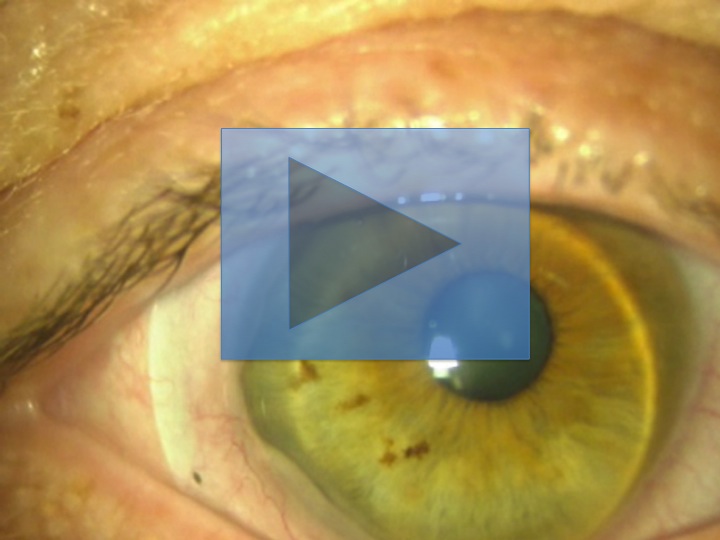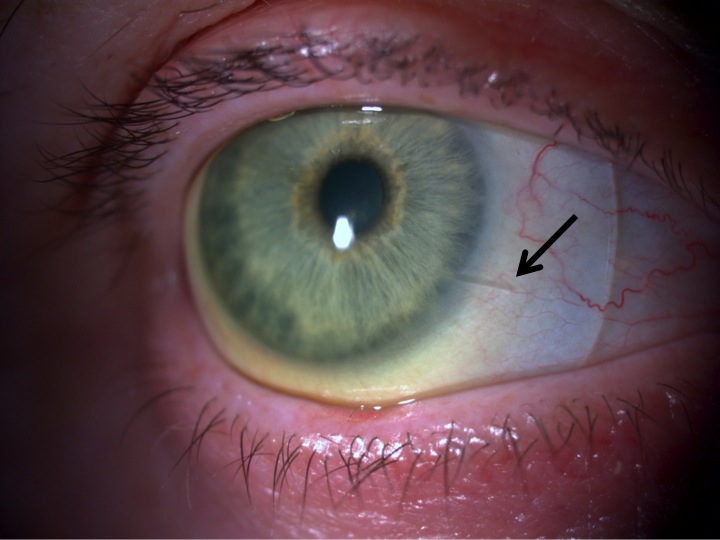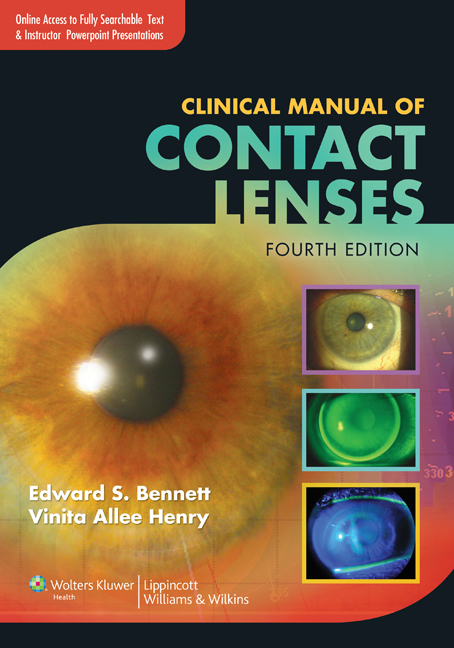|
|

International Newsletter and Forum on Rigid Gas Permeable Contact Lenses, Corneal Shape, Health and Vision |
|
|
|
|
|
|
|
|
|
|
Creative with Cornea
 Fall is the not only the season of leafs and pumpkins - but also of conferences. Lots to explore in the field - the contact lens field, that is. London Heathrow (UK) hosted the first Contact Lens Specialist Symposium (CLSS) - a fascinating two-day symposium for contact lens specialists who have a passion for our profession. On the first day, the meeting meticulously dissected everything we know today about ocular surface shape - corneal, but also limbal and anterior scleral shape. Then, based on that thinking, the second day focused on how that shape could be best served with current state-of-the-art contact lenses, from sag-height soft lens fitting, (R)GPs and multifocal lenses, to orthokeratology, corneal cross-linking, fitting the irregular cornea and how to fit and manage the scleral lens patient. The meeting was extremely well received, with lots of positive feedback. See the link below for coverage of the conference by Alison Ewbank in the Optician (a UK publication). A week or so later, the European Society for Cataract and Refractive Surgery (ESCRS) meeting was held almost literally in my backyard, here in Amsterdam. It was nice, for a change, to hop on my bike with my badge to attend some lectures. It was very refreshing at this meeting, at least for me, to see all the surgical options regarding 'managing keratoconus'. Corneal rings seem to be having a bit of a revival (using the femtosecond laser), and different techniques for corneal transplant (full versus a variety of partial keratoplasties) appear to serve different patients depending on their condition. And cross-linking - boy was there a lot (or should I say an overload) of presentations on that! The theme of both meetings though seemed to be 'let's be creative with cornea', by either following the shape of the cornea as closely as possible (with our state-of-the-art contact lenses) or by altering that shape (surgically) - to best serve our patients. |
Scleral Lens Complications
| |
|
Sophie's Choice
 At CLSS, Sophie Taylor-West covered her personal 'top 10 scleral lens complications' from least to most invasive for her and her patients. At Number 10, air bubbles beneath the lens was mentioned as one of the more common problems in scleral lens practice (insertion bubbles should be differentiated from fitting-related bubbles), followed by (Number 9) blanching of the conjuctival vessels. She urged us to watch for rebound redness (after lens removal), although this is something the patient typically would tell us as well. 'Conjunctival bunching' (Number 8) is a term she used, previously also described as 'conjunctival loose tissue' or 'conjunctival prolapse' (see next item in this newsletter). Pain/discomfort as a combined subcategory was mentioned at spot Number 7 - which often can be located under the upper eyelid, and lens design issues may play a role. Solution interaction may be another cause. Settling back, or sinking, of the lens after initial lens application was rated at Number 6 - which can be in the 50-200 micron range, but is hard to predict. Corneal staining (Number 5), although seen quite rarely, may be caused by corneal touch or (again) solutions. Surface deposits/non-wetting of the scleral lens surface was rated as a quite annoying problem (Number 4), with a variety of possible causes in which makeup issues (applying makeup after lens application is the recommendation) and eye and face-creams may play a role. She recommended using non-moisterising soap, to plasma treat all lenses, to use deep cleaning agents (such as Progent) and to look for eyelid disease. Interestingly, handling problems were rated as one of the highest (Number 3) potential problems in scleral lens practice. The Number 2 spot was clinched by conjunctival redness, also often a solution problem - followed by (Number 1) misting (or fogging) under the lens, possibly a result of milking of the conjuctival tissue (also see next item). A full report covering this top 10 will appear in the next Contact Lens Monthly in the Optician. At CLSS, Sophie Taylor-West covered her personal 'top 10 scleral lens complications' from least to most invasive for her and her patients. At Number 10, air bubbles beneath the lens was mentioned as one of the more common problems in scleral lens practice (insertion bubbles should be differentiated from fitting-related bubbles), followed by (Number 9) blanching of the conjuctival vessels. She urged us to watch for rebound redness (after lens removal), although this is something the patient typically would tell us as well. 'Conjunctival bunching' (Number 8) is a term she used, previously also described as 'conjunctival loose tissue' or 'conjunctival prolapse' (see next item in this newsletter). Pain/discomfort as a combined subcategory was mentioned at spot Number 7 - which often can be located under the upper eyelid, and lens design issues may play a role. Solution interaction may be another cause. Settling back, or sinking, of the lens after initial lens application was rated at Number 6 - which can be in the 50-200 micron range, but is hard to predict. Corneal staining (Number 5), although seen quite rarely, may be caused by corneal touch or (again) solutions. Surface deposits/non-wetting of the scleral lens surface was rated as a quite annoying problem (Number 4), with a variety of possible causes in which makeup issues (applying makeup after lens application is the recommendation) and eye and face-creams may play a role. She recommended using non-moisterising soap, to plasma treat all lenses, to use deep cleaning agents (such as Progent) and to look for eyelid disease. Interestingly, handling problems were rated as one of the highest (Number 3) potential problems in scleral lens practice. The Number 2 spot was clinched by conjunctival redness, also often a solution problem - followed by (Number 1) misting (or fogging) under the lens, possibly a result of milking of the conjuctival tissue (also see next item). A full report covering this top 10 will appear in the next Contact Lens Monthly in the Optician.
|
|
The Whole Spectrum
 | | Courtesy: Patrick Caroline |
In the September issue of Contact Lens Spectrum, scleral lenses were very well represented, covering a wide range of topics. Patrick Caroline and Mark André look at the subject of conjunctival prolapse. A new theory was introduced, in which the shape the shape of the ocular surface, particularly a lower corneal elevation inferiorly, could be responsible for the phenomenon. The prolapse occurred directly in the area of lowest relative height in the case report presented in Contact Lens Spectrum. The effect of the prolapse also was discussed, and this may not be as benign as has been generally accepted up to now according to the authors, as the flap adhered and attached to the cornea in one of their patients. Another case of corneal physiology management in scleral lens wear was presented by William Miller from the University of Houston in his 'Treatment Plan' column - talking about 'scleral contact lens fog'. Preventing impingement of the lens and optimizing the tear reservoir - both in volume and in size (a plano lens configuration is suggested as most optimal), does seem beneficial in his opinion. Taking solutions into account is another variable to consider. Otherwise, a mid-day break may be the only option, although this is not a popular one with patients. To top things off: Luciano Bastos and Marcelo Bittencourt report on a customized scleral fit in a difficult case of keratoconus in this September issue of the journal. Click picture to see video on conjunctival prolapse by Patrick Caroline - Pacific University (OR USA)
Contact Lens Spectrum, Sept 2013
|
|
To Straighten Things Out

A study by Visser et al from the Netherlands, published in the October issue of Optometry & Vision Science, looked at the use of a new bitangential toric scleral lens design in a cohort of patients including those who have keratoconus, ocular surface diseases, penetrating keratoplasty and other forms of irregular astigmatism. This lens is developed based on the assumption that the limbal and anterior scleral shape is, first of all, more 'straight' (or tangential) than what was thought based on our previous understanding of the ocular anatomy. Both the limbal shape and the scleral shape often appear to have an almost straight rather than a curved profile. Furthermore, the anterior ocular surface of the normal eye appears to be non-rotationally symmetric in nature: e.g. is not spherical. Certain parts may be flatter (especially nasally) than other parts (like the temporal-inferior and temporal-superior, for instance). In total, 213 eyes of 144 patients were fitted with this bitangential scleral lens (basically a toric scleral lens with a tangential periphery) with an average diameter of 20.0mm (diameter range was 18.5 to 21.5mm), and no pre-selection was done in terms of existing anterior ocular shape. The median stabilization axis of the lens (stabilized on the sclera) was 140 degrees (range 0 to 180 degrees) in the right eyes and 60 degrees (range 0 to 180 degrees) in the left eyes. The authors concluded that the bitangential scleral lens fitting and performance characteristics were clear and effective for the health professional and the patient. Photo: Henny Otten, Visser Contactlenzen NL
|
Clinical Manual of Contact Lenses

The fourth edition of the clinical manual of contact lenses, by Ed Bennett and Vinita Henry, was just released. It is an impressive 720-pages-thick resource with an even more impressive list of contributors: fifty experts mostly from North America. The book covers everything from corneal topography to soft and (R)GP lens fit and a range of specialty lens topics, including orthokeratology, aphakia, keratoconus and the postsurgical cornea. Two new topics that really stand out are 'Children and Contact Lenses' by Jeff Walline, Marjorie Rah and Chris Sindt, and a comprehensive chapter covering scleral lens fitting and managenent by Greg DeNaeyer, Jason Jedlicka and Muriel Schornack, featuring lots of practical advice and richly decorated with clinical images and 11 case reports.
|

Corneal vault is an important topic in scleral lens fitting. Large diameter scleral lenses that rest solely on the sclera typically vault the cornea and bear their weight on the conjunctiva overlying the sclera. There is debate among experts about what constitutes optimal vault. If there is significant corneal contact, staining is likely to occur. It is crucial to carefully inspect the cornea after removing a scleral lens to ensure that there was no significant corneal contact. In the case presented, the corneal staining after lens removal corresponds to the region of corneal touch with the scleral lens. When the scleral lens is reapplied, it may once again vault the cornea because the lens has not settled. If there is uncertainty about corneal contact, the patient may have to return for a re-evaluation of the vault once the lens has fully settled. Scheduling afternoon appointments of scleral lens evaluations can ensure proper lens settling. If, after lens settling for six or more hours, it vaults the cornea, then staining should not be present.
|
Global Specialty Lens Symposium (GSLS) - Las Vegas
GSLS is gearing up for the 2014 edition of its annual 3.5 day meeting that focuses on the latest techniques and technologies for the successful  management of ocular conditions using today's specialty contact lenses. Accredited for continuing education under COPE, NCLE, and JCAHPO, the meeting will offer approximately 30 credit hours - and last year hosted participants from 32 countries. The first day of the symposium hosts special meetings, where topics like Myopia Control, Billing and Coding, the Aging Eye and Scleral Lens Fitting get all the attention they deserve in sessions from 8:30am to 12:30pm. The full GSLS program is available online now; the meeting will be held in the Rio Hotel, Las Vegas (USA). management of ocular conditions using today's specialty contact lenses. Accredited for continuing education under COPE, NCLE, and JCAHPO, the meeting will offer approximately 30 credit hours - and last year hosted participants from 32 countries. The first day of the symposium hosts special meetings, where topics like Myopia Control, Billing and Coding, the Aging Eye and Scleral Lens Fitting get all the attention they deserve in sessions from 8:30am to 12:30pm. The full GSLS program is available online now; the meeting will be held in the Rio Hotel, Las Vegas (USA).
|
|
|
|
|
|
|
I-site is an educational newsletter that is distributed on a monthly basis and provides an update on rigid gas permeable related topics (scientific research, case reports and other publications worldwide). I-site is objective and non-political. Its editor Eef van der Worp, optometrist, PhD, FAAO, FBCLA, FIACLE, FSLS is a lecturer for a variety of industry partners, but is not related to any specific company. Please contact us at: i-site@netherlens.com.
|
|
|